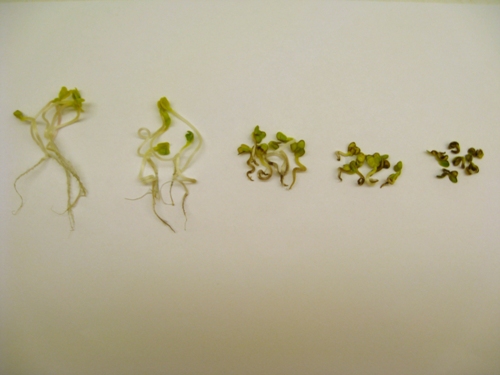A team of researchers from the University of Massachusetts Amherst (UMass) and the National Institute of Standards and Technology (NIST) has demonstrated the negative impact of engineered nanoparticles on plants for the first time.
 Graphic showing that increasing exposure to cupric oxide bulk particles (BPs) and nanoparticles (NPs) by radish plants also increases the impact on growth with NPs showing the largest impact. From left to right, the exposure concentrations are 0; 100 parts per million (ppm) BPs; 1,000 ppm BPs; 100 ppm NPs; and 1,000 ppm NPs (showing a severely stunted plant). (Credit: H. Wang, U.S. Environmental Protection Agency)
Graphic showing that increasing exposure to cupric oxide bulk particles (BPs) and nanoparticles (NPs) by radish plants also increases the impact on growth with NPs showing the largest impact. From left to right, the exposure concentrations are 0; 100 parts per million (ppm) BPs; 1,000 ppm BPs; 100 ppm NPs; and 1,000 ppm NPs (showing a severely stunted plant). (Credit: H. Wang, U.S. Environmental Protection Agency)
The research team led by Bryant C. Nelson, a NIST chemist, has proved that cupric oxide nanoparticles can accumulate inside plants and cause DNA damage. These nanoparticles were able to reach plant root cells under lab conditions and produced several mutagenic DNA base lesions.
This research work is part of an effort by NIST to classify the possible environmental, health and safety hazards of nanomaterials and devise techniques to detect and measure the risks. For this purpose, the research team exposed the samples of radishes and two ryegrasses to cupric oxide bulk particles, cupric oxide nanoparticles and simple copper ions separately. The team then utilized a pair of ultrasensitive spectrographic techniques to measure the formation and accretion of DNA base lesions and the amount of copper consumed by the plants.
The team discovered that the number of lesions generated in radishes that were exposed to nanoparticles was double that of radishes exposed to bulk particles. Moreover, the amount of copper taken up by the radishes from the nanoparticles was considerably higher than that from the bulk particles. However, the ryegrasses’ DNA damage profiles were different from that of radishes, meaning that nanoparticle-triggered DNA damage was relied on the concentration of the nanoparticles and on the plant species.
In the end, the research team demonstrated that the negative impact of the cupric oxide nanoparticles was much higher on plant growth. These nanoparticles had inhibited the growth of shoots and roots in all three specimens tested. However, in this test, the plants were exposed to nanoparticle concentrations that were much higher than normally found in soil. The team’s next step is to conduct a similar study on the impact of titanium dioxide nanoparticles on rice plants.